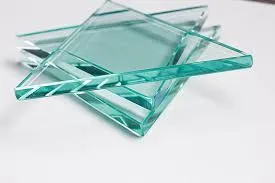Understanding the Cutting and Floating Process of Float Glass
Float glass is a widely used type of flat glass that is famous for its smooth surface and high clarity. This glass is produced using the float glass process, which involves melting raw materials and floating the molten glass on a bed of molten tin. The cutting of float glass is a critical stage in its production, determining its shape and size for various applications ranging from windows to table tops.
The float glass manufacturing process begins with the heating of raw materials, including silica sand, soda ash, and limestone, which are combined in a furnace. Once melted, the molten glass is carefully poured onto a pool of molten tin, where it spreads out and forms a uniform sheet. This method ensures that the glass has a perfectly flat surface and consistent thickness, qualities that are essential for both aesthetic and functional purposes.
Understanding the Cutting and Floating Process of Float Glass
Manual cutting involves using a handheld glass cutter which scores the surface of the glass. The cutter has a sharp wheel that glides over the glass, creating a shallow groove. The operator then applies pressure along the score line, causing the glass to break cleanly. This method allows for high flexibility in cutting custom sizes and shapes but requires a steady hand and experience to ensure a clean cut.
cutting float glass
Automated cutting systems have become increasingly popular due to their efficiency and precision. These systems employ computer numerical control (CNC) technology to determine the optimal cutting patterns, minimizing waste and maximizing yield. The machine can handle large sheets of glass and execute multiple cuts simultaneously, which significantly speeds up the production process. Automated systems are particularly advantageous for mass production where uniformity is crucial.
Scoring is another essential aspect of the cutting process. After the initial cut, operators may score the glass further to create smaller pieces or intricate shapes. This secondary scoring is done with careful measurements to ensure that the final product meets the specifications required by customers.
The quality of the cut float glass is crucial as it directly affects its usability and aesthetic appeal. After cutting, the glass pieces undergo inspection for any defects or irregularities. Quality control measures are put in place to ensure that only the best products move forward in the production line.
In conclusion, the cutting of float glass is an essential process that combines artistry with technology. Whether through manual or automated methods, achieving precise cuts ensures that float glass can meet the diverse needs of the market. From architectural installations to everyday glassware, the cutting process plays a vital role in delivering high-quality float glass products.
 Afrikaans
Afrikaans  Albanian
Albanian  Amharic
Amharic  Arabic
Arabic  Armenian
Armenian  Azerbaijani
Azerbaijani  Basque
Basque  Belarusian
Belarusian  Bengali
Bengali  Bosnian
Bosnian  Bulgarian
Bulgarian  Catalan
Catalan  Cebuano
Cebuano  Corsican
Corsican  Croatian
Croatian  Czech
Czech  Danish
Danish  Dutch
Dutch  English
English  Esperanto
Esperanto  Estonian
Estonian  Finnish
Finnish  French
French  Frisian
Frisian  Galician
Galician  Georgian
Georgian  German
German  Greek
Greek  Gujarati
Gujarati  Haitian Creole
Haitian Creole  hausa
hausa  hawaiian
hawaiian  Hebrew
Hebrew  Hindi
Hindi  Miao
Miao  Hungarian
Hungarian  Icelandic
Icelandic  igbo
igbo  Indonesian
Indonesian  irish
irish  Italian
Italian  Japanese
Japanese  Javanese
Javanese  Kannada
Kannada  kazakh
kazakh  Khmer
Khmer  Rwandese
Rwandese  Korean
Korean  Kurdish
Kurdish  Kyrgyz
Kyrgyz  Lao
Lao  Latin
Latin  Latvian
Latvian  Lithuanian
Lithuanian  Luxembourgish
Luxembourgish  Macedonian
Macedonian  Malgashi
Malgashi  Malay
Malay  Malayalam
Malayalam  Maltese
Maltese  Maori
Maori  Marathi
Marathi  Mongolian
Mongolian  Myanmar
Myanmar  Nepali
Nepali  Norwegian
Norwegian  Norwegian
Norwegian  Occitan
Occitan  Pashto
Pashto  Persian
Persian  Polish
Polish  Portuguese
Portuguese  Punjabi
Punjabi  Romanian
Romanian  Russian
Russian  Samoan
Samoan  Scottish Gaelic
Scottish Gaelic  Serbian
Serbian  Sesotho
Sesotho  Shona
Shona  Sindhi
Sindhi  Sinhala
Sinhala  Slovak
Slovak  Slovenian
Slovenian  Somali
Somali  Spanish
Spanish  Sundanese
Sundanese  Swahili
Swahili  Swedish
Swedish  Tagalog
Tagalog  Tajik
Tajik  Tamil
Tamil  Tatar
Tatar  Telugu
Telugu  Thai
Thai  Turkish
Turkish  Turkmen
Turkmen  Ukrainian
Ukrainian  Urdu
Urdu  Uighur
Uighur  Uzbek
Uzbek  Vietnamese
Vietnamese  Welsh
Welsh  Bantu
Bantu  Yiddish
Yiddish  Yoruba
Yoruba  Zulu
Zulu 

